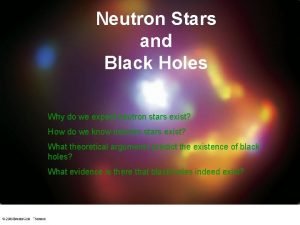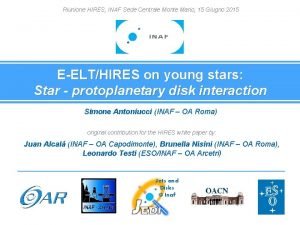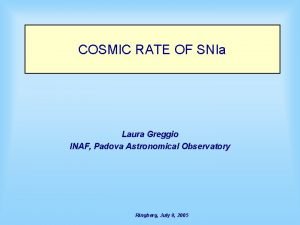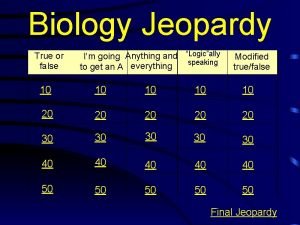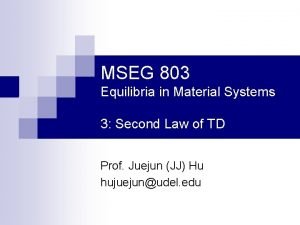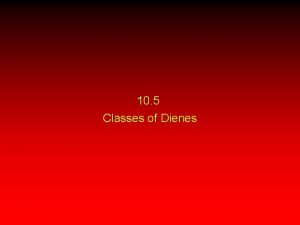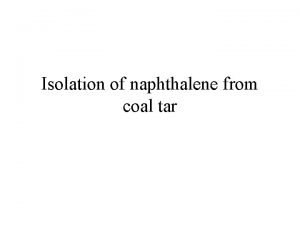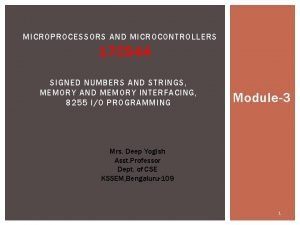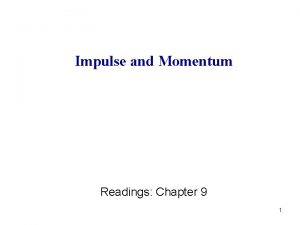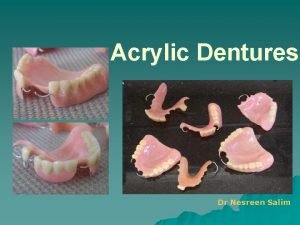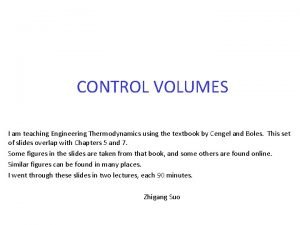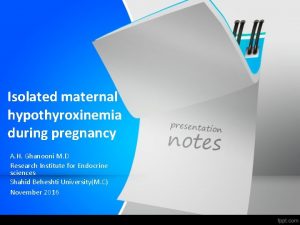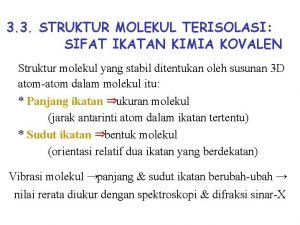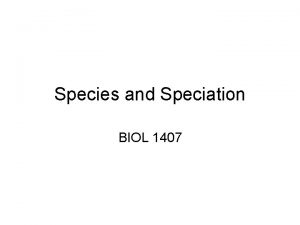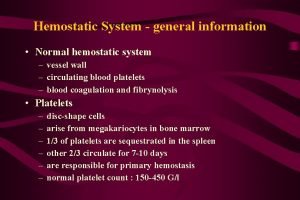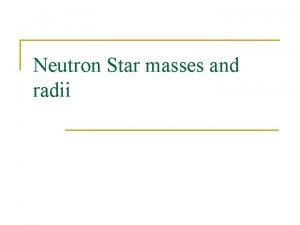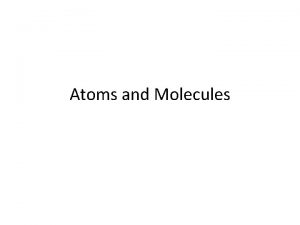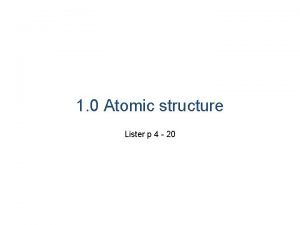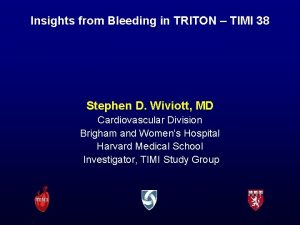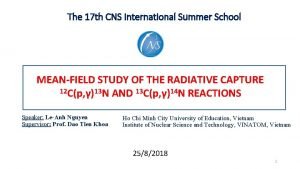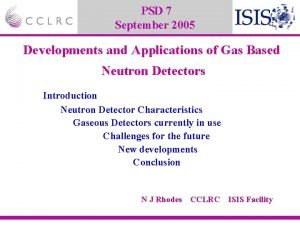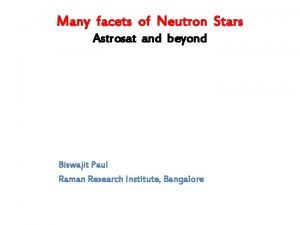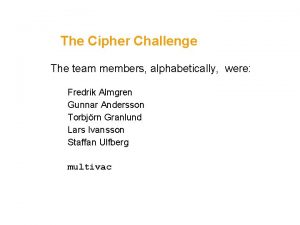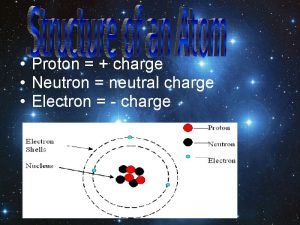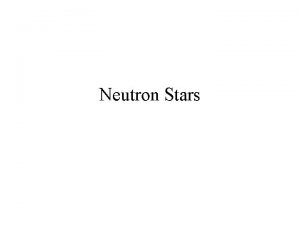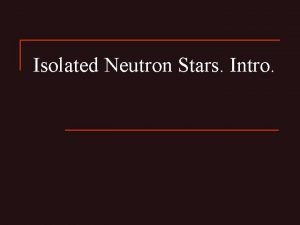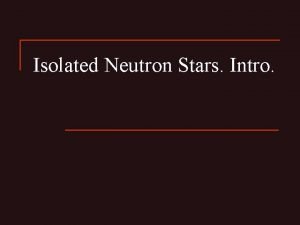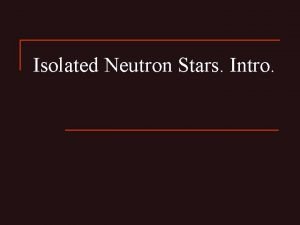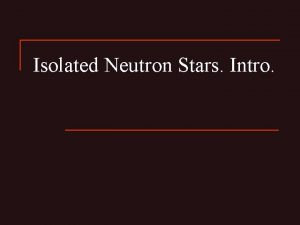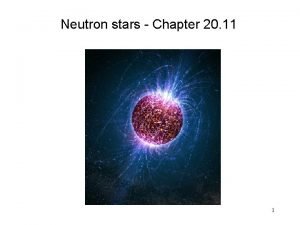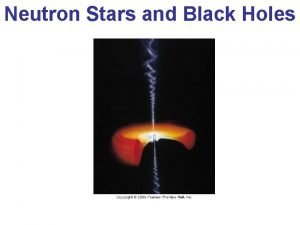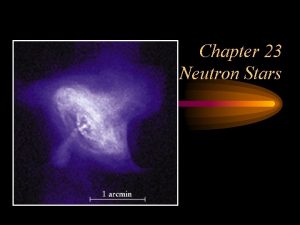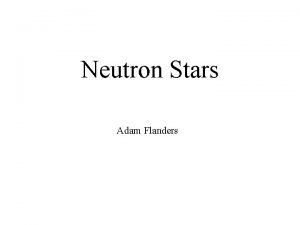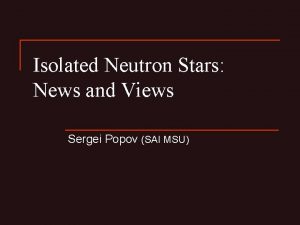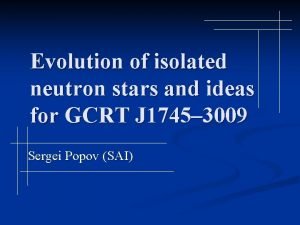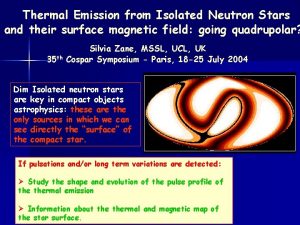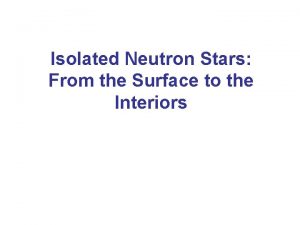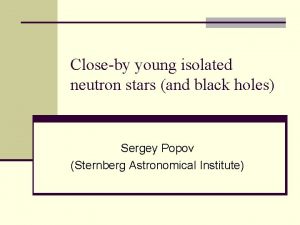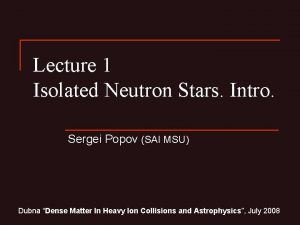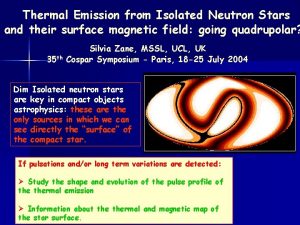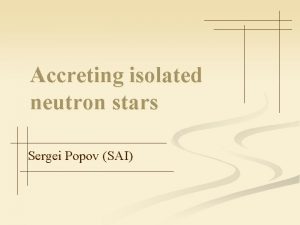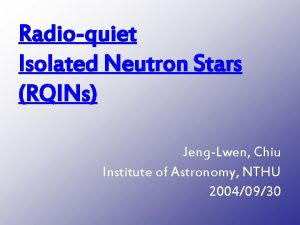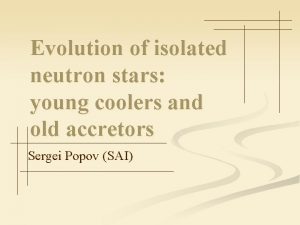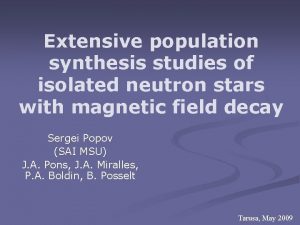ISOLATED NEUTRON STARS Andrea Tiengo INAF IASFMilano on





































- Slides: 37

ISOLATED NEUTRON STARS Andrea Tiengo INAF, IASF-Milano on behalf of Roberto Turolla Dept. of Physics, University of Padova NHXM - ESRIN, November 12 -13 2009 1

INSs in the X-rays • At present > 110 INSs detected in X-rays • Large majority are “normal” (rotation powered) radiopulsars (~ 90 sources, including high-B pulsars and ms pulsars) • Radio-silent (quasi), X/γ-ray bright INSs – Anomalous X-ray pulsars and Soft γ-ray repeaters (AXPs and SGRs, the magnetar candidates) – Central compact objects in SNRs (CCOs) – Rotating radio transients (RRa. Ts) – X-ray dim neutrons stars (XDINSs) – Geminga and Geminga-like objects • “Isolated” NSs in binaries: Soft X-ray transients (SXTs) NHXM - ESRIN, November 12 -13 2009 2

• X-ray emission ubiquitous over the P-Ṗ diagram • Detected from objects with extremely different – Ages: from young Crab-like to old PSRs – Magnetic fields: from low B ms PSRs to magnetars Kondratiev et al. (2009) NHXM - ESRIN, November 12 -13 2009 3

Different mechanisms powering X-ray emission SGR+AXPs XDINSs HBPSRs Rotation RRa. Ts LX = Ė rot Cooling Magnetic from Becker (2009) NHXM - ESRIN, November 12 -13 2009 4

INS spectrum: thermal plus non-thermal component (magnetospheric, if rotation-powered LNT ~ Ė ~ t-β, β ≈ 2 -4) total non-thermal Young, < 1 kyr: non-thermal component dominates (Crab, PSR 1509 -58) Middle-aged, 10 -100 kyr: thermal emission from the star surface (Vela, Geminga) + SGRs/AXPs NHXM - ESRIN, November 12 -13 2009 Old, > 1 Myr: no magnetospheric activity (XDINSs) + SXTs 5

Some Like It Hot Page, Geppert & Weber (2006) • NSs are born very hot (T ≈ 1011 K) and progressively cool down • Surface temperature drops quickly and then stays at ≈ 105 – 106 K for about 1 Myr • Thermal emission at ≈ 100 e. V, L ≈ 1031 – 1032 erg/s • Thermal component detected ~ 40 INSsmagnetic dissipation, inflowing Heatingin processes: magnetospheric currents, accretion NHXM - ESRIN, November 12 -13 2009 6

BB or Not BB ? Turolla, Zane & Drake (2004) BB at Teff Zavlin & Pavlov (2002) Magnetic H atmosphere models Bare NS H models Whatever the state of the surface, the emitted hard photons decouple deeper k. T ~ hνp, e: emission strongly suppressed thermal radiation is NOT a blackbody in the atmopsphere where T is higher NHXM - ESRIN, November 12 -13 2009 7

Fast (and Furious) • Electrons accelerated by electric field • High-energy CR/ICS photons produce pairs via γ + B e+ + e • e emit synchrotron radiation (+ ICS) • Hard power-law spectrum (Γ ≈ 1. 5 – 2) Hirotani (2006) NHXM - ESRIN, November 12 -13 2009 8

Twist, Twist Little Star • In “normal” PSRs currents flow along open field lines • In an ultramagnetized NS the “wound up” internal field is > 1015 G • It stresses and deforms the crust • The external field twists up ( ) • Currents flow along the closed field lines NHXM - ESRIN, November 12 -13 2009 Thompson & Duncan (2001) 9

The Seven Thermally Emitting Neutron Stars (XDINSs) • 7 known (the “Magnificent Seven”), plus 2 candidates • Nearby (D 100 – 500 pc) • Radio-quiet, no association with SNRs • X-ray pulsations (P 3 – 10 s) • Ṗ 10 -14 s/s → B (1 – 4) x 1013 G, τc a few Myr • Very faint optical counterparts (f. X/fopt > 104) • Soft, purely thermal spectrum (k. T 50 – 100 e. V), LX 1031 1032 erg/s • Broad spectral feature(s) at 100 – 700 e. V NHXM - ESRIN, November 12 -13 2009 10

Rotating Radio Transients (RRa. Ts) • 11 sources detected in the Parkes Multibeam Survey (Mc. Laughlin et al 2006) • Burst duration 2 -30 ms, interval 4 min-3 hr • Periods in the range 0. 4 -7 s • Period derivative measured in 3 sources: B 1012 -1014 G, τc 0. 1 – 3 Myr • RRa. T J 1819 -1458 detected in the X-rays, spectrum soft and thermal (k. T ~ 114 e. V), absorption feature at ~ 1 ke. V (Reynolds et al 2006; Mc. Laughlin et al 2008) P, Ṗ, spatial distribution, lack of pulsed radio emission (and X-ray properties) are very similar to those of the XDINSs NHXM - ESRIN, November 12 -13 2009 11

Central Compact Objects in SNRs (CCOs) • 7 bona fide sources • Located near the center of young SNRs; no radio emission At least two absorption lines detected; no PWNs De Luca et al. (2004) 33 erg/s • Mostly thermal spectrum (k. T 0. 7 0. 3 – 0. 4 ke. V), L 10 X ke. V • P 0. 1 – 0. 4 s (in 3 sources); limits on Ṗ → B < 1011 G (Halpern et al. 2007; Gotthelf & Halpern 2007, 2009) 1. 4 ke. V • Cas A may have similar properties (Pavlov & Luna 2009) • Absorption features in the spectrum of 1 E 1207. 4 -5209 supports low B, if electron cyclotron Are CCOs “antimagnetars” ? Need to ne born with P 0 P to have τc τSNR 1 kyr. RCW 103 has P = 6. 67 hr. Are CCOs a class ? NHXM - ESRIN, November 12 -13 2009 12

Soft γ Repeaters and Anomalous X-ray Pulsars (SGRs and AXPs) • 6 SGRs and 10 AXPs known (plus a few candidates); some AXPs are transients (TAXPs) • X-ray pulsations (P 2 – 12 s) • Ṗ 10 -10 – 10 -12 s/s → B 1014 – 1015 G, τc 1 – 10 kyr • Emission of short bursts (Δt 0. 1 s, LX 1039 – 1041 erg/s); giant flares (L up to 1047 erg/s) from 3 SGRs • Persistent X-ray flux (0. 1 – 10 ke. V): thermal (k. T 0. 5 ke. V) plus non-thermal component (Γs 1. 5 – 4); LX 1033 – 1035 erg/s; variable spectral and timing properties (months/yrs) • Transient radio emission in 2 AXPs; IR/opt counterparts • Hard power-law tails (20 – 200 ke. V), Γh < Γs in AXPs NHXM - ESRIN, November 12 -13 2009 13

What is producing the persistent X-ray spectrum ? • Thermal emission from part of the surface kept hot by returning currents/magnetic dissipation (corroborated by TAXPs evolution) • Soft PL from resonant upscattering of thermal photons by e± moving along the closed field lines; quantitative models fit well, but unclear if charges can have γ 1 • No definite model for the hard PL. Does it come from a different region ? What is the origin of the IR/optical radiation ? • Passive disk ? IR, but not optical pulsations • Inner magnetosphere (CR from moderately relativistic particles) ? Possibly Bursts 1 E 1841 -045 (Rea et al. 2008) • Double BB spectrum and/or absorption lines ? • Crustal or magnetospheric origin? XTE J 1810 (Israel et al. 2004) NHXM - ESRIN, November 12 -13 2009 14

Unity in the Diversity ? Why are INSs different ? • “Intrinsic” diversity – Progenitors with different properties (P, B, M, …) → differences in their formation/very early evolution – Magnetars require peculiar conditions to form, either in the fossil field or in dynamo scenario – Antimagnetar CCOs need to be born with long P and low B • Evolution – RRa. Ts XDINSs (Popov et al 2006), no RRa. T-like emission detected from XDINSs yet (Kondratiev et al. 2009) – HBPSRs XDINSs (Kaplan & Van Kerkwijk 2009) – quiescent TAXPs may look quite similar to XDINSs • An incomplete knowledge of their properties (SGRs and AXPs !) NHXM - ESRIN, November 12 -13 2009 15

The Future and NHXM: a few ideas Broad-band (phase-resolved) X-ray spectroscopy of rotation-powered pulsars with NHXM – Constraining non-thermal emission in young and middleaged pulsars allows to better constrain thermal emission models. (Non-simultaneous) observations at soft X-rays are also required – Observations of Fermi pulsars in hard X-rays: test of pulsar non-thermal emission models (SEDs and phase-resolved SEDs) NHXM - ESRIN, November 12 -13 2009 16

The Future and NHXM: a few ideas Broad-band (phase-resolved) X-ray spectroscopy of AXPs/SGRs with NHXM – Spectral analysis in the poorly explored ~ 10 -20 ke. V band, where the hard tails emerge from softer X-ray component – High sensitivity coverage of the 1 -80 ke. V energy band allows to study the (possibly correlated) variability of the soft and hard components in magnetars NHXM - ESRIN, November 12 -13 2009 17

AXP 4 U 0142+61 XMM-Newton data (spectra integrated over few hours) INTEGRAL data (spectra integrated over several weeks) NHXM - ESRIN, November 12 -13 2009 18

NHXM: AXP 4 U 0142+61, 20 ks NHXM - ESRIN, November 12 -13 2009 19

The Future and NHXM: a few ideas Broad-band (phase-resolved) X-ray spectroscopy of AXPs/SGRs with NHXM – Spectral analysis in the poorly explored ~10 -20 ke. V band, where the hard tails emerge from softer X-ray component – High sensitivity coverage of the 1 -80 ke. V energy band allows to study the (possibly correlated) variability of the soft and hard components in magnetars – Broad band spectra of bursts: pile-up at low energies and low sensitivity in hard X-rays have limited these studies up to now NHXM - ESRIN, November 12 -13 2009 20

NHXM: SGR burst (BB+BB or BB+PL) NHXM - ESRIN, November 12 -13 2009 21

The Future and NHXM: a few ideas Broad-band X-ray imaging with NHXM – Pulsar Wind Nebulae (PWN): ~10 -15 detected by INTEGRAL; NHXM can discover tens of new PWN, and study them with better spatial resolution disentangle PWN and pulsar hard X-ray emission – If low background in LED, dust-scatterings from bright magnetar bursts (or GRBs): up to now very rare, but allow to constrain dust properties, burst spectrum and source distance NHXM - ESRIN, November 12 -13 2009 22

Swift/XRT: t=1. 37 d XMM/EPIC: t=12. 3 d Tiengo et al. 2009, submitted to Ap. J NHXM - ESRIN, November 12 -13 2009 23

The Future and NHXM: a few ideas X-ray polarimetry with NHXM – Non-thermal emission of X-ray pulsars: different beaming geometry from polar caps, slot gaps and outer magnetosphere models, with different energy dependence. Up to now: polarization detected in radio and optical only for Crab pulsar, with slot gap model favored – Thermal emission of X-ray pulsars: polarization is different for atmosphere or condensed surface. NHXM - ESRIN, November 12 -13 2009 24

Magnetized H atmosphere Condensed H surface Pavlov & Zavlin (2000) Van Adelsberg et al. (2005) NHXM - ESRIN, November 12 -13 2009 25

The Future and NHXM: a few ideas X-ray polarimetry with NHXM – Non-thermal emission of X-ray pulsars: different beaming geometry from polar caps, slot gaps and outer magnetosphere models, with different energy dependence. Up to now: polarization detected in radio and optical only for Crab, with slot gap model favored – Thermal emission of X-ray pulsars: polarization is different for atmosphere or condensed surface – Magnetars: test for up-scattering emission models NHXM - ESRIN, November 12 -13 2009 26

Nobili, Turolla & Zane (2008) Up-scattering in twisted magnetosphere should suppress the polarization of the (strongly polarized) seed X-ray photons NHXM - ESRIN, November 12 -13 2009 27

The Future and NHXM: a few ideas Spatially-resolved X-ray polarimetry with NHXM Linear polarization in Crab nebula detected at soft (Weisskopf et al. 1978) and hard X-rays (Dean et al. 2008), but imaging is needed to map B and estimate maximum particle energy ) L A r cto R G E NT I e v n r la o (P NHXM - ESRIN, November 12 -13 2009 tio a iz Dean et al. 2008 28

The Future and NHXM: a few ideas Spatially-resolved X-ray polarimetry with NHXM Weisskopf 2008 Linear polarization in Crab nebula detected at soft (Weisskopf et al. 1978) and hard X-rays (Dean et al. 2008), but imaging is needed to map B and estimate maximum particle energy NHXM - ESRIN, November 12 -13 2009 29

Conclusions What requirements to study INSs with NHXM? • Disentangle thermal/non-thermal emission spectral components Broad energy band (good Aeff <1 ke. V desirable but not required) • Phase-resolved spectroscopy and polarimetry Good time resolution (~1 s for magnetars, ~10 ms for pulsars, ~1 ms for ms pulsars) • Magnetar variability fast (hours/days, the sooner the better) response to To. O and high pile-up limit for bursts • PWN and dust halo good PSF and low background; spatially-resolved polarimetry NHXM - ESRIN, November 12 -13 2009 30

NHXM - ESRIN, November 12 -13 2009 31

NHXM - ESRIN, November 12 -13 2009 32

NHXM - ESRIN, November 12 -13 2009 33

Geminga (XMM; Caraveo et al. 2004) PSR J 1930+1852 (Chandra; Lu et al. 2006) RX J 1856 -3754 (XMM+Chandra; Burwitz et al. 2003) AXP 1 E 2259+586 (XMM; Rea et al. 2008) NHXM - ESRIN, November 12 -13 2009 34

Middle-aged, cooling INSs (right T for age) Origin in the O-B associations of the Gould Belt can explain local overabundance Why a blackbody spectrum ? Are these “bare” INSs ? What is the nature of the absorption features ? RX J 0720 Epic • Proton cyclotron ? No, if multiple lines are detected, as in RX J 1308 Haberl et al. (2004) • Atomic transitions in the strong B- field ? Ok, but requires an atmosphere… • Absorption edges in the emission from the condensed surface ? Possibly RBS 1774 (Zane et al 2008) Why the “optical excess” ? • Thermal emission from a cooler region ? No, RBBcold too large • A “thin” H atmosphere on top the condensed surface ? Possibly What is producing the long-term changes in RXHohle J 0720 ? Optical excess ~ 35 et al. (2009) Motch (2007) A precessing INS, the first seen in X-rays ? NHXM - ESRIN, November 12 -13 2009 35

Tapping the NS surface Comparison of observations with theoretical models provides Ts, Bs, chemical composition, R (and M) • Ts(t) → thermal evolution • R, M → NS matter equation of state • Chemical composition → NS formation and interaction with surrounding medium What is the correct model for thermal emission ? NHXM - ESRIN, November 12 -13 2009 36

A “Hard” Surface ? • NS surface composition: either H (accreted from ISM Turolla et al (2004) Fe H or from fallback of SN material) or heavy elements condensation (C, Ne, Fe) (Lai 2001) • Under typical conditions surface layers are in gaseous state: NS atmosphere Fe C He condensation • For sufficiently low T and large B (and depending on H (Medin & Lai Fe the surface can be in a condensed 2006, 2007) composition) state: “bare” NS NHXM - ESRIN, November 12 -13 2009 37
 How are neutrons formed
How are neutrons formed Inaf sede centrale
Inaf sede centrale Laura greggio
Laura greggio Schnauzer dogs there are three sizes
Schnauzer dogs there are three sizes Biology jeopardy
Biology jeopardy Isolated system
Isolated system Classify the diene as conjugated, isolated, or cumulated.
Classify the diene as conjugated, isolated, or cumulated. Types of stairs in building construction
Types of stairs in building construction Isolated feature combined feature effects
Isolated feature combined feature effects Coal tar naphthalene
Coal tar naphthalene Cs-44
Cs-44 Why did some ancient greek settlements trade?
Why did some ancient greek settlements trade? Isolated system
Isolated system Special purpose amplifiers
Special purpose amplifiers Isolated systolic hypertension
Isolated systolic hypertension Spoon denture definition
Spoon denture definition What are the three main types of clouds
What are the three main types of clouds Earth is a closed system
Earth is a closed system Nozzle and diffuser
Nozzle and diffuser Trombocytopenic purpura
Trombocytopenic purpura Isolated maternal hypothyroxinemia
Isolated maternal hypothyroxinemia Kovalen polar
Kovalen polar Mechanical isolation
Mechanical isolation Isolated versus memory mapped i/o
Isolated versus memory mapped i/o How does cumulus clouds form
How does cumulus clouds form Megakariocytes
Megakariocytes Phil wharton active isolated stretching
Phil wharton active isolated stretching Neutron star
Neutron star Atom proton neutron electron
Atom proton neutron electron Lithium mass number
Lithium mass number Timi neutron
Timi neutron James chadwick adalah penemu
James chadwick adalah penemu Neutron capture
Neutron capture Spallation neutron source
Spallation neutron source Neutron star
Neutron star Cipher neutron
Cipher neutron Proton charge
Proton charge Alpha beta gamma neutron
Alpha beta gamma neutron
